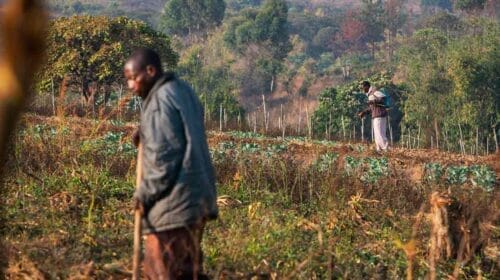African Development Bank’s seed-bulking scheme boosts cassava yields in Zambia

For centuries, African farmers across the continent have grown cassava. The woody shrub was introduced to Africa from South America by Portuguese traders in the 16th Century and grows well in the continent’s drylands and produces nutritious, calorie-rich meals.
But Zambia’s cassava growers were not deriving as much out of the crop as was possible. Farmers in the southern African country used low-quality planting materials and suffered from poor harvests leading to hunger and poverty across many of the country’s villages.
To help tackle these problems, the African Development Bank, through its Technologies for African Agriculture Transformation in the Savannahs (TAAT-S) flagship initiative, implemented by the International Institute of Tropical Agriculture (IITA), provided Zambian farmers with a solution known as “seed bulking”. This involves collecting seeds from a target crop and then growing them in a controlled setting. Using this method, farmers can multiply their bank of seeds, making them more secure and able to scale-up productivity.
In 2019, ITTA worked with agriculture specialists from the Zambian government and local partners to set up 58 cassava seed-bulking farms, with smallholder farmers managing the local outfits.
Five types of high-yielding cassava seeds were successfully introduced in an effort to boost yields and make the landlocked nation less reliant on food imports.
Operating under the TAAT-S initiative, each seed-bulking farm covered two or three types of high-yielding cassava seeds, to increase productivity to 20-30 tonnes per hectare, from a baseline of below 10 tonnes previously.
The farms were all located near various cassava processing facilities including through the recently constructed cassava milling plant developed by the AfDB-GAFSP financed Agriculture Productivity and Market Enhancement Project (APMEP).
The scheme is already up and running, and each seed-bulking farm was expected to utilise 174 hectares of land to multiply cassava seeds at the 58 locations spread across a nation of more than 17 million people.
This would translate into the planting of 1,740 hectares of cassava seed farms in 2021, which would generate seeds for cultivation to produce around 43,500 tonnes of cassava root. Once milled into flour, this would represent 10,875 tonnes of food — capable of feeding more than 3.6 million people.
In 2022, the replanting of cuttings from cassava roots would scale up across 17,400 hectares of land to produce some 435,000 tonnes of root the following year. Some 23,000 tonnes of excess root could then be processed into starch, making Zambia less reliant on imports.
The scheme is important because agriculture is a driver of Zambia’s $27.5 billion (2019) economy. The sector provides work for more than half of the country’s workers.
In addition to cassava, Zambian farmers grow corn, sorghum, rice, peanuts, sunflower seeds, vegetables, flowers, tobacco, cotton, sugarcane and coffee. They also rear cattle, goats, pigs and poultry. Almost a third of Zambia’s land is devoted to farming.
Agriculture is one of the Bank’s main focus areas under its “Feed Africa,” High Five priority, which aims to tackle high rates of poverty, unemployment and malnutrition in sub-Saharan Africa.
Climate change has become an added challenge. Flooding, droughts and swarms of locusts have ravaged harvests across Africa in recent years, pushing farmers into poverty and making governments spend more foreign currency on imports.
Experts believe that modified seeds could help millions of smallholder farmers to get bigger harvests and earn extra cash. Getting improved seeds to more farmers will also help lower food prices, make it easier for parents to feed their children and therefore reduce malnutrition and other health concerns.




